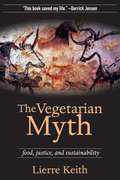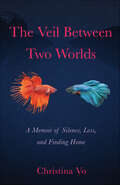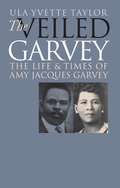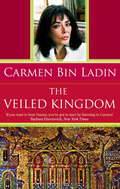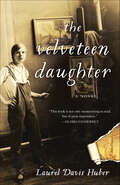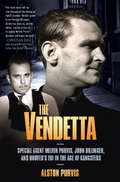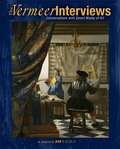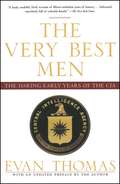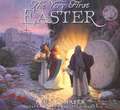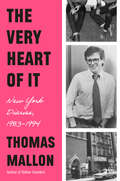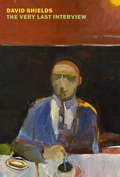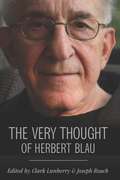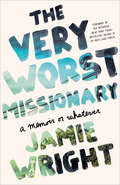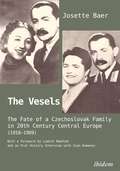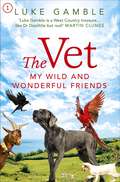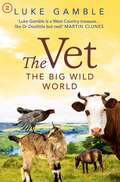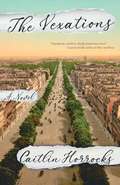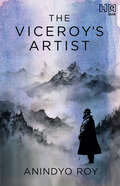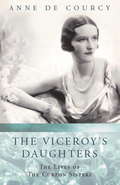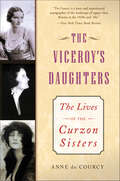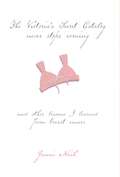- Table View
- List View
The Vegetarian Myth: Food, Justice, and Sustainability
by Lierre KeithPart memoir, nutritional primer, and political manifesto, this controversial examination exposes the destructive history of agriculture--causing the devastation of prairies and forests, driving countless species extinct, altering the climate, and destroying the topsoil--and asserts that, in order to save the planet, food must come from within living communities. In order for this to happen, the argument champions eating locally and sustainably and encourages those with the resources to grow their own food. Further examining the question of what to eat from the perspective of both human and environmental health, the account goes beyond health choices and discusses potential moral issues from eating--or not eating--animals. Through the deeply personal narrative of someone who practiced veganism for 20 years, this unique exploration also discusses alternatives to industrial farming, reveals the risks of a vegan diet, and explains why animals belong on ecologically sound farms.
The Veil Between Two Worlds: A Memoir of Silence, Loss, and Finding Home
by Christina VoChristina Vo has always struggled with the concept of “home.” The daughter of an emotionally distant father and a mother who died when she was just fourteen, she continues to grapple with that legacy of loss and her constant quest to, as a fortysomething, find a reconciliation with the shape her life has taken. In January 2021, feeling a call to be closer to the land, she decides to leave San Francisco—this time permanently, she hopes—and set off on a road trip with one of her closest friends, David.Christina and David begin their journey with an ayahuasca ceremony in Santa Barbara, then continue on to Ojai and ultimately Santa Fe—two magical lands that serve as deep portals for healing. Throughout their travels, Christina reflects on the recent and distant past: her relationships, her past experiences in Santa Barbara and Ojai (where she stayed for nine months around her fortieth birthday, two years ago) and her evolving understanding of her relationship with her parents. All the while, she ponders how the past has shaped her current identity as a single, childless, and motherless woman in her forties. Within the context of intimate friendship, she discovers how thin the veil between worlds can be, and gradually comes to realize that her mother’s spirit has accompanied her since day one of her journey.Deeply reflective and ultimately joyful, Vo’s memoir takes us on a journey between two worlds—the physical and the spiritual—that eventually brings her to a newfound understanding of how to deepen connections with others, as well as to a place of peace and home within herself.
The Veiled Garvey
by Ula Yvette TaylorIn this biography, Ula Taylor explores the life and ideas of one of the most important, if largely unsung, Pan-African freedom fighters of the twentieth century: Amy Jacques Garvey (1895-1973). Born in Jamaica, Amy Jacques moved in 1917 to Harlem, where she became involved in the Universal Negro Improvement Association (UNIA), the largest Pan-African organization of its time. She served as the private secretary of UNIA leader Marcus Garvey; in 1922, they married. Soon after, she began to give speeches and to publish editorials urging black women to participate in the Pan-African movement and addressing issues that affected people of African descent across the globe. After her husband's death in 1940, Jacques Garvey emerged as a gifted organizer for the Pan-African cause. Although she faced considerable male chauvinism, she persisted in creating a distinctive feminist voice within the movement. In her final decades, Jacques Garvey constructed a thriving network of Pan-African contacts, including Nnamdi Azikiwe, Kwame Nkrumah, George Padmore, and W. E. B. Du Bois. Taylor examines the many roles Jacques Garvey played throughout her life, as feminist, black nationalist, journalist, daughter, mother, and wife. Tracing her political and intellectual evolution, the book illuminates the leadership and enduring influence of this remarkable activist.
The Veiled Kingdom
by Carmen Bin LadinOn September 11th 2001, Carmen Bin Ladin heard the news on the radio that the Twin Towers had been struck. She instinctively knew that her brother-in-law's name would be linked to these horrifying acts of terrorism, and her heart went out to the victims in America. She also knew that her life and the lives of her family would never be the same again. In 1974 Carmen, half Swiss and half Persian, married Yeslam Bin Ladin and found herself inside the complex and vast clan of Bin Laden, part of a society that at that point she neither knew nor understood. Carmen Bin Ladin's story takes us inside one of the most powerful, secretive and repressive kingdoms in the world.
The Velveteen Daughter: A Novel
by Laurel Davis HuberThe Velveteen Daughter reveals for the first time the true story of two remarkable women: Margery Williams Bianco, the author of one of the most beloved children's books of all time,The Velveteen Rabbit,and her daughter Pamela, a world-renowned child prodigy artist whose fame at one time greatly eclipses her mother's. But celebrity at such an early age exacts a great toll. Pamela's dreams elude her as she struggles with severe depressions, an overbearing father, an obsessive love affair, and a spectacularly misguided marriage. Throughout, her life raft is her mother. The glamorous art world of Europe and New York in the early 20th century and a supporting cast of luminaries—Eugene O'Neill and his wife Agnes (Margery's niece), Pablo Picasso, Gertrude Vanderbilt Whitney, and Richard Hughes, author of A High Wind in Jamaica—provide a vivid backdrop to the Biancos' story. From the opening pages, the novel will captivate readers with its multifaceted and illuminating observations on art, family, and the consequences of genius touched by madness.
The Vendetta: Special Agent Melvin Purvis, John Dillinger, and Hoover's FBI in the Age of Gangsters
by Alston PurvisIn "The Vendetta," author Alston Purvis recounts the story of his father, Melvin Purvis, the iconic G-man and public hero made famous by his remarkable sweep of the great Public Enemies of the American DepressionOCoJohn Dillinger; Pretty Boy Floyd, and Baby Face Nelson. PurvisOCOs successes led FBI boss J. Edgar Hoover to grow increasingly jealous, to the point where he vowed to bring down Purvis. Hoover smeared PurvisOCOs reputation, and tried to erase his name from all records of the FBI's greatest triumphs. This book sets the record straight, and provides a grippingly authentic new telling of the gangster era, seen from the perspective of the pursuers. "
The Vermeer Interviews: Conversations with Seven Works of Art
by Bob RaczkaIn this innovative look at seven paintings by Jan Vermeer, author Bob Raczka takes on the role of interviewer and the people in the paintings become his willing subjects.
The Very Best Men: The Daring Early Years of the CIA
by Evan ThomasDrawing on extensive interviews with old spooks and the social friends and family of his subjects, The Very Best Men is a fascinating narrative that brings to life a crucial piece of American history.The Very Best Men is the story of the CIA's early days as told through the careers of four glamorous, daring, and idealistic men who ran covert operations for the government from the end of World War II to Vietnam. Evan Thomas re-creates the personal dramas and sometimes tragic lives of Frank Wisner, Richard Bissell, Tracy Barnes, and Desmond FitzGerald, who risked everything to contain the Soviet threat. Within the inner circles of Washington, they were regarded as the best and the brightest. They planned and acted to keep the country out of war -- by stealth and "political action" and to do by cunning and sleight of hand what great armies could not, must not be allowed to do. In the end, they were too idealistic and too honorable, and were unsuited for the dark, duplicitous life of spying. Their hubris and naïveté led them astray, producing both sensational coups and spectacular blunders like the Bay of Pigs and the failed assassination attempts on foreign leaders in the early 1960s. Thomas draws on the CIA's own secret histories, to which he has had exclusive access, as well as extensive interviews, to bring to life a crucial piece of American history.
The Very First Easter
by Paul L. Maier"Would you like to hear the true story of the very first Easter? " Christopher prefers stories that are real; truth, not fiction. So in their home, far away from Jerusalem, his parents tell about the sorrow and joy of Jesus' trial, death, and resurrection. This book places the focus of Easter on the truth of God's story- His plan for the salvation of mankind through Jesus Christ. It will become a treasured classic to be enjoyed year after year."
The Very Heart of It: New York Diaries, 1983-1994
by Thomas MallonFrom the renowned novelist and critic, an exquisite collection of journal entries from the 1980s and &’90s, tracking a young, gay author&’s literary coming-of-age in New York during the AIDS crisisIn 1983, Thomas Mallon was still unknown. A literature professor at Vassar College, he spent his days traveling from Manhattan to campus, reviewing books to make ends meet and searching the city for his own purpose and fulfillment. The AIDS epidemic was beginning to surge in New York City, the ever-bustling epicenter of literary culture and gay life, alive with parties, art, and sex.Though he didn&’t know it, everything would soon change for Mallon. Riding the success of his debut, A Book of One&’s Own, he became a fixture within the city&’s literary scene, crossing paths with cultural giants and becoming an editor at GQ. He captured it all in his daily journals. But in some ways it was the worst possible time for a gay coming-of-age in the city. One of his lovers succumbed to AIDS, and the illness of others was both a heartbreaking reality and a constant reminder of his own exposure.Tracing his own life day by day, Mallon evokes all that those years encompassed: the hookups, intensifying politics, personal tragedies, as well as his own blossoming success and eventual romantic happiness. The Very Heart of It is a brilliant and bewitching look into the daily life of one of our most important literary figures, and a keepsake from a bygone era.
The Very Last Interview
by David ShieldsIn the spirit of his highly acclaimed and influential book Reality Hunger, David Shields has composed a mordantly funny, relentlessly self-questioning self-portrait based on questions that interviewers have asked him over forty years.David Shields decided to gather every interview he&’s ever given, going back nearly forty years. If it was on the radio or TV or a podcast, he transcribed it. He wasn&’t sure what he was looking for, but he knew he wasn&’t interested in any of his own answers. The questions interested him—approximately 2,700, which he condensed and collated to form twenty-two chapters focused on such subjects as Process, Childhood, Failure, Capitalism, Suicide, and Comedy. Then, according to Shields, &“the real work began: rewriting and editing and remixing the questions and finding a through-line.&”The result is a lacerating self-demolition in which the author—in this case, a late-middle-aged white man—is strangely, thrillingly absent. As Chuck Klosterman says, &“The Very Last Interview is David Shields doing what he has done dazzlingly for the past twenty-five years: interrogating his own intellectual experience by changing the meaning of what seems both obviously straightforward and obviously wrong.&”Shields&’s new book is a sequel of sorts to his seminal Reality Hunger: A Manifesto, which Literary Hub recently named one of the most important books of the last decade. According to Kenneth Goldsmith, &“Just when you think Shields couldn&’t rethink and reinvent literature any further, he does it again. The Very Last Interview confirms Shields as the most dangerously important American writer since Burroughs.&”
The Very Thought of Herbert Blau
by Joseph Roach Clark LunberryHerbert Blau (1926–2013) was the most influential theater theorist, practitioner, and educator of his generation. He was the leading American interpreter of the works of Samuel Beckett and as a director was instrumental in introducing works of the European avant-garde to American audiences. He was also one of the most far-reaching and thoughtful American theorists of theater and performance, and author of influential books such as The Dubious Spectacle, The Audience, and Take Up the Bodies: Theater at the Vanishing Point. In The Very Thought of Herbert Blau, distinguished artists and scholars offer reflections on what made Blau's contributions so visionary, transformative, and unforgettable, and why his ideas endure in both seminar rooms and studios. The contributors, including Lee Breuer, Sue-Ellen Case, Gautam Dasgupta, Elin Diamond, S. E. Gontarski, Linda Gregerson, Martin Harries, Bill Irwin, Julia Jarcho, Anthony Kubiak, Daniel Listoe, Clark Lunberry, Bonnie Marranca, Peggy Phelan, Joseph Roach, Richard Schechner, Morton Subotnick, Julie Taymor, and Gregory Whitehead, respond to Blau's fierce and polymorphous intellect, his relentless drive and determination, and his audacity, his authority, to think, as he frequently insisted, "at the very nerve ends of thought."
The Very Worst Missionary: A Memoir or Whatever
by Jamie Wright“The reason you love Jamie (or are about to) is because she says exactly what the rest of us are thinking, but we’re too afraid to upset the apple cart. She is a voice for the outlier, and we’re famished for what she has to say.” --Jen Hatmaker, New York Times bestselling author of Of Mess and Moxie and For the Love Wildly popular blogger "Jamie the Very Worst Missionary" delivers a searing, offbeat, often hilarious memoir of spiritual disintegration and re-formation. As a quirky Jewish kid and promiscuous punkass teen, Jamie Wright never imagines becoming a Christian, let alone a Christian missionary. She is barely an adult when the trials of motherhood and marriage put her on an unexpected collision course with Jesus. After finding her faith at a suburban megachurch, Jamie trades in the easy life on the cul-de-sac for the green fields of Costa Rica. There, along with her family, she earnestly hopes to serve God and change lives. But faced with a yawning culture gap and persistent shortcomings in herself and her fellow workers, she soon loses confidence in the missionary enterprise and falls into a funk of cynicism and despair. Nearly paralyzed by depression, yet still wanting to make a difference, she decides to tell the whole, disenchanted truth: Missionaries suck and our work makes no sense at all! From her sofa in Central America, she launches a renegade blog, Jamie the Very Worst Missionary, and against all odds wins a large and passionate following. Which leads her to see that maybe a "bad" missionary--awkward, doubtful, and vocal—is exactly what the world and the throngs of American do-gooders need. The Very Worst Missionary is a disarming, ultimately inspiring spiritual memoir for well-intentioned contrarians everywhere. It will appeal to readers of Nadia Bolz-Weber, Jen Hatmaker, Ann Lamott, Jana Reiss, Mallory Ortberg, and Rachel Held Evans.
The Vesels: The Fate of a Czechoslovak Family in Twentieth-Century Central Europe (1918–1989)
by Josette BaerThis book deals with the Slovak National Uprising (SNP) that was launched on 29 August 1944 in Banská Bystrica, Slovakia. In the West, the uprising is an under-researched topic in the history of WWII. The Slovak state was an ally of Nazi Germany, but the uprising proved that the population did not share the regime’s ideology.
The Vet 1: my wild and wonderful friends
by Luke Gamble'Luke Gamble is a West Country treasure. Like Dr Doolittle, but real!' MARTIN CLUNESFresh out of university, vet Luke Gamble joined a mixed practice in Dorset, run by the stern but benevolent Mr Spotswode. He found himself quickly thrust into the real world of veterinary medicine: truculent farmers, out-of-hours-surgery, nasty biting squirrels, operating on frog's eyeballs and some of the harsher facts of farming life, like dealing with a tragic outbreak of foot and mouth. Luke dreams of setting up his own practice, and finding his place in the big wild world. These dreams, however, are never quite as straightforward as they may seem. In the first instalment of his memoir, the young vet not only learns much about his trade, but also learns a lot about himself, along the way developing a group of close friends, both animal and human. The most important of these is Cordelia - the woman of his dreams - and his quest to win her heart is a marathon.Warm-hearted, witty and full of weird and wonderful tales, The Vet is the perfect read for animal lovers.
The Vet 2: The Big Wild World
by Luke GambleLuke Gamble is a West Country treasure. Like Dr Doolittle, but real!' MARTIN CLUNESLuke Gamble cut his teeth as a mixed practice vet in the West Country. Now it's time to see if he can stand on his own two feet. Wild stallions, drowning cows and constipated snakes aside, Luke's challenges have only just begun. He's come a long way from the fresh-faced graduate vet we met in The Vet 1: my wild and wonderful friends. He's marrying the girl of his dreams while launching his own practice, Pilgrims. On top of that, he's managing his international veterinary charity and two other veterinary businesses. On his extreme travels around the world, Luke dodges hippos and chimps, and swaps the familiar farms of home for the refugee camps of Africa, all on his quest to make a difference.But Luke is more than just an international vet. He's also a husband, a friend, an entrepreneur and, potentially, an Ironman triathlete. Does he have what it takes to juggle it all?For fans of Arthur and Supervet, The Vet 2: the big wild world is an exhilarating, inspiring and moving adventure that animal lovers and thrill seekers will adore.
The Vet: My Wild and Wonderful Friends
by Luke GambleFresh out of university Luke joins a mixed practice in Dorset, run by the stern but benevolent Mr Spotswode and is quickly thrust into the real world of veterinary medicine: truculent farmers, out-of-hours-surgery, nasty biting squirrels, operating on frog's eyeballs and some of the harsher facts of farming life like dealing with an outbreak of foot and mouth and subsequent slaughter. Luke's dream is to set up on his own and find his place in the world. These things, however, are never quite straightforward. Across the course of this memoir, the young vet not only learns much about his trade, but about his own character - and develops a group of close friends - both animal and human - who will stay with his across his career. The most important of these is Cordelia - the woman of his dreams - his quest to win her heart is a marathon!
The Vet: the Big Wild World
by Luke GambleLuke Gamble cut his teeth as a mixed practice vet in the West Country. Now it's time to see if he can stand on his own two feet. Wild stallions, drowning cows and constipated snakes aside, Luke's challenges have only just begun.
The Vexations
by Caitlin HorrocksA kaleidoscopic debut novel about love, family, genius, and the madness of art, circling the life of eccentric composer Erik Satie and La Belle Époque Paris, from a writer who is "wildly entertaining" (San Francisco Chronicle), "startlingly ingenious" (Boston Globe), and "impressively sharp" (New York Times Book Review).Erik Satie begins life with every possible advantage. But after the dual blows of his mother's early death and his father's breakdown upend his childhood, Erik and his younger siblings -- Louise and Conrad -- are scattered. Later, as an ambitious young composer, Erik flings himself into the Parisian art scene, aiming for greatness but achieving only notoriety. As the years, then decades, pass, he alienates those in his circle as often as he inspires them, lashing out at friends and lovers like Claude Debussy and Suzanne Valadon. Only Louise and Conrad are steadfast allies. Together they strive to maintain their faith in their brother's talent and hold fast the badly frayed threads of family. But in a journey that will take her from Normandy to Paris to Argentina, Louise is rocked by a severe loss that ultimately forces her into a reckoning with how Erik -- obsessed with his art and hungry for fame -- will never be the brother she's wished for.With her buoyant, vivid reimagination of an iconic artist's eventful life, Caitlin Horrocks has written a captivating and ceaselessly entertaining novel about the tenacious bonds of family and the costs of greatness, both to ourselves and to those we love.
The Viceroy's Artist: A Novel
by Anindyo RoySomewhere in the foothills of the Himalayas, a sixty-two-year-old English painter falls off his sketching stool. Overweight, asthmatic and prone to attacks of epilepsy, Edward Lear is nevertheless on a mission – to paint the mighty Kanchenjunga for his patron, the Viceroy of India.Lear is an oddity, an outsider, simultaneously fascinated and repelled by the world the British have built in India. Even as he battles the fatigue of travelling on pony carts, jampans and trains, Lear reflects on those who run the vast machinery of the Empire – administrators and missionaries, kitmutgars and kamsamahs.Duelling pompous British officers with his wry humour, Lear turns his ear to the polyphony of local languages to compose nonsense poetry with a uniquely Indian flavour. Woven into this vivid account are flashes from Lear's own life – deep-seated fears stemming from an unhappy childhood and the memory of unfulfilled adult relationships. Inspired by the journals of this celebrated artist and poet, Anindyo Roy brings to life Lear's little-known Indian sojourns. In lyrical prose, and occasional verse, The Viceroy's Artist paints a picture of an exceptional man who inspires by his unhindered imagination, curiosity and compassion for the world.
The Viceroy's Daughters
by Anne de CourcyThe lives of the three daughters of Lord Curzon: glamorous, rich, independent and wilful.Irene (born 1896), Cynthia (b.1898) and Alexandria (b.1904) were the three daughters of Lord Curzon, Viceroy of India 1898-1905 and probably the grandest and most self-confident imperial servant Britain ever possessed. After the death of his fabulously rich American wife in 1906, Curzon's determination to control every aspect of his daughters' lives, including the money that was rightfully theirs, led them one by one into revolt against their father. The three sisters were at the very heart of the fast and glittering world of the Twenties and Thirties.Irene, intensely musical and a passionate foxhunter, had love affairs in the glamorous Melton Mowbray hunting set. Cynthia ('Cimmie') married Oswald Mosley, joining him first in the Labour Party, where she became a popular MP herself, before following him into fascism. Alexandra ('Baba'), the youngest and most beautiful, married the Prince of Wales's best friend Fruity Metcalfe. On Cimmie's early death in 1933 Baba flung herself into a long and passionate affair with Mosley and a liaison with Mussolini's ambassador to London, Count Dino Grandi, while enjoying the romantic devotion of the Foreign Secretary, Lord Halifax. The sisters see British fascism from behind the scenes, and the arrival of Wallis Simpson and the early married life of the Windsors. The war finds them based at 'the Dorch' (the Dorchester Hotel) doing good works. At the end of their extraordinary lives, Irene and Baba have become, rather improbably, pillars of the establishment, Irene being made one of the very first Life Peers in 1958 for her work with youth clubs.
The Viceroy's Daughters: The Lives Of The Curzon Sisters
by Anne de CourcyThe lives of the three daughters of Lord Curzon: glamorous, rich, independent and wilful.Irene (born 1896), Cynthia (b.1898) and Alexandria (b.1904) were the three daughters of Lord Curzon, Viceroy of India 1898-1905 and probably the grandest and most self-confident imperial servant Britain ever possessed. After the death of his fabulously rich American wife in 1906, Curzon's determination to control every aspect of his daughters' lives, including the money that was rightfully theirs, led them one by one into revolt against their father. The three sisters were at the very heart of the fast and glittering world of the Twenties and Thirties.Irene, intensely musical and a passionate foxhunter, had love affairs in the glamorous Melton Mowbray hunting set. Cynthia ('Cimmie') married Oswald Mosley, joining him first in the Labour Party, where she became a popular MP herself, before following him into fascism. Alexandra ('Baba'), the youngest and most beautiful, married the Prince of Wales's best friend Fruity Metcalfe. On Cimmie's early death in 1933 Baba flung herself into a long and passionate affair with Mosley and a liaison with Mussolini's ambassador to London, Count Dino Grandi, while enjoying the romantic devotion of the Foreign Secretary, Lord Halifax. The sisters see British fascism from behind the scenes, and the arrival of Wallis Simpson and the early married life of the Windsors. The war finds them based at 'the Dorch' (the Dorchester Hotel) doing good works. At the end of their extraordinary lives, Irene and Baba have become, rather improbably, pillars of the establishment, Irene being made one of the very first Life Peers in 1958 for her work with youth clubs.
The Viceroy's Daughters: The Lives of the Curzon Sisters
by Anne de CourcyBased on unpublished letters and diaries, The Viceroy's Daughters is a riveting portrait of three spirited and wilful women who were born at the height of British upper-class wealth and privilege.The oldest, Irene, never married but pursued her passion for foxes, alcohol, and married men. The middle, Cimmie, was a Labour Party activist turned Fascist. And Baba, the youngest and most beautiful, possessed an appetite for adultery that was as dangerous as it was outrageous.As the sisters dance, dine, and romance their way through England's most hallowed halls, we get an intimate look at a country clinging to its history in the midst of war and rapid change. We obtain fresh perspectives on such personalities as the Duke and Duchess of Windsor, Oswald Mosley, Nancy Astor and the Cliveden Set, and Lord Halifax. And we discover a world of women, impeccably bred and unabashedly wilful, whose passion and spirit were endlessly fascinating.
The Victor Marx Story: With God, All Things Are Possible
by Victor Marx Wayne Atcheson James WerningThis is the story of Victor - he was the son of a pimping, drug dealing, street fighter, involved in the Cajun Mafia. Victor wanted nothing to do with his dad - that's me - and you can't blame him. I wanted nothing to do with his either.
The Victoria's Secret Catalog Never Stops Coming: And Other Lessons I Learned from Breast Cancer
by Jennie NashBreast cancer made Jennie Nash a wise old woman at the age of thirty-six. She learned, among other things, that her instincts are good, her kids are really resilient, and that, in the fight against breast cancer, the journey for patients, family, and friends can be a surprisingly positive, life-changing experience. Some five years younger than the AMA-recommended age for mammograms, Jennie Nash insisted she be tested, not because of a lump but because of a hunch brought on by a friend's battle with lung cancer. Jennie was as shocked to discover as her friend had been that cancer knows no age limits. From detection and surgery to reconstruction and recovery, Jennie gives readers a road map for a journey no one chooses to take. She details both the large and small lessons learned along the way: the importance of a child's birthday cake; the pleasure of wearing a beautiful, provocative red dress; how to be grateful rather than guilty when someone brings lasagne to the door; and that sometimes the only difference between getting to live and having to die is luck. A celebration of survival, Jennie Nash's account transforms one of life's most harrowing experiences into a story of reassurance and enlightenment.
